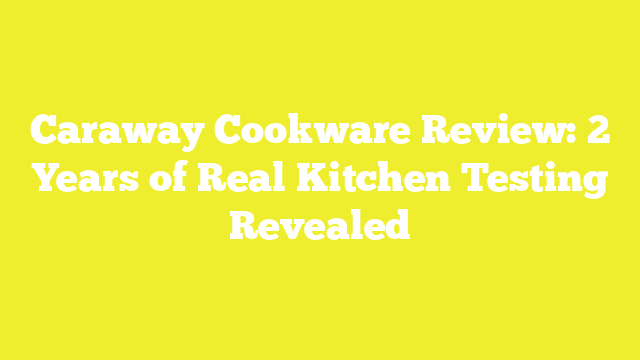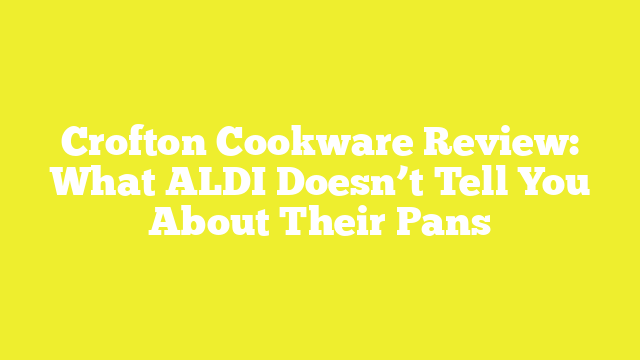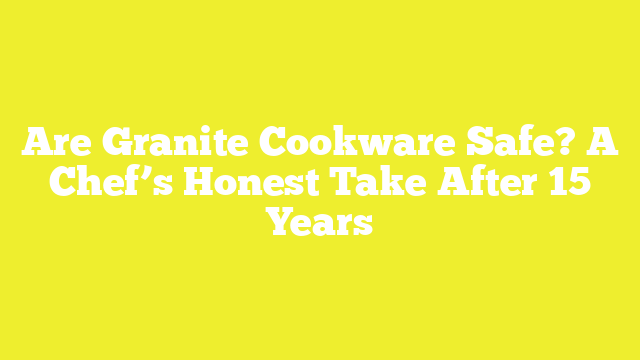Are Scratched Ceramic Pans Safe? What Kitchen Experts Won’t Tell You
Are scratched ceramic pans safe? While many of us believe ceramic cookware is a healthier alternative to traditional non-stick pans, there’s more to the story than what meets the eye. A single scratch on a conventional non-stick pan can release around 9,100 plastic particles into our food, and ceramic-coated alternatives aren’t without their own risks.
We often hear about ceramic cookware being free of PTFE, PFAS, and toxic metals, making it a seemingly perfect choice for health-conscious cooking. However, what many kitchen experts won’t tell you is that ceramic pans usually have an aluminum layer underneath, which can potentially leach into our foods when the coating is compromised. In fact, several health agencies recommend minimizing dietary aluminum intake as much as possible, though the long-term consequences remain uncertain.
In this comprehensive guide, we’ll examine the real safety concerns of damaged ceramic cookware, help you identify dangerous wear patterns, and provide practical solutions for maintaining your kitchen’s safety standards.
Understanding Ceramic Pan Damage
Ceramic pans, despite their popularity among home cooks, require careful attention to maintain their safety and effectiveness. Understanding the various types of damage these pans can sustain is crucial for making informed decisions about their continued use.
Types of scratches and their causes
Metal utensils rank as the primary culprit behind ceramic pan damage. Additionally, harsh cleaning methods, particularly abrasive scrubbers like steel wool, can deteriorate the ceramic coating. Furthermore, what might appear as scratches could actually be plastic residue from utensils smearing across the surface.
Visual signs of unsafe damage
Several indicators signal when a ceramic pan becomes unsafe for use:
- Surface Imperfections: Deep scratches or chips that expose the underlying material demand immediate replacement
- Color Changes: A significant fade in the pan’s vibrant color indicates wearing of the ceramic coating
- Structural Issues: Warping or distortion makes the pan unstable and potentially hazardous
Notably, a network of small cracks, known as crazing, can develop from thermal expansion and contraction. Moreover, overheating can cause dark brown stains similar to those seen on cookie sheets after extended use.
Impact of daily use on ceramic coating
The ceramic coating naturally degrades over time, particularly under specific conditions. High temperatures accelerate this wear – although ceramic pans withstand higher heat than traditional non-stick cookware, sustained exposure to elevated temperatures breaks down the coating more rapidly.
Even with careful maintenance, ceramic-coated pans typically last only a few years. The coating releases microscopic amounts each time the pan heats up. Furthermore, daily cleaning, especially with incorrect methods, can significantly impact longevity. Using harsh detergents or abrasive cleaners damages the surface, making food increasingly likely to stick.
To extend your pan’s lifespan, consider these essential practices:
- Use wooden or silicone utensils exclusively
- Clean with warm, soapy water and soft sponges
- Never heat an empty pan, as this causes rapid deterioration
Most significantly, performance issues often emerge within months of regular use. Food beginning to stick persistently indicates the non-stick properties have diminished. At this point, while the pan might still function, its effectiveness has notably decreased.
Health Risks of Damaged Ceramic Cookware
Recent studies reveal concerning findings about damaged ceramic cookware that many manufacturers don’t openly discuss. Understanding these risks becomes crucial for making informed decisions about your kitchen safety.
Chemical leaching concerns
The safety concerns of damaged ceramic cookware extend beyond mere performance issues. Research indicates that scratched ceramic coatings can release titanium dioxide nanoparticles into food. These particles accumulate in vital organs, potentially causing serious health complications.
A single scratch on certain non-stick pans releases approximately 9,100 plastic particles. Furthermore, ceramic pans typically contain an aluminum layer underneath, which may leach into food once the coating is compromised.
Most concerning is the presence of heavy metals in some ceramic cookware. Studies have identified instances of:
- Lead contamination from imported ceramics
- Cadmium exposure from unglazed surfaces
- Titanium dioxide buildup affecting reproductive health
Signs of toxic exposure
Recognizing symptoms of toxic exposure from damaged ceramic cookware requires vigilance. Medical research has documented several indicators:
Early Warning Signs:
- Persistent fatigue
- Abdominal discomfort
- Headaches
- Unexplained joint pain
Advanced Symptoms: Blood lead concentrations exceeding 2 μmol/L often trigger noticeable health effects. At 2.5 μmol/L, anemia becomes prevalent, whereas neurological symptoms emerge at 4.5 μmol/L.
Physical examinations might reveal hypertension when blood lead levels reach 0.48 μmol/L. Nevertheless, many individuals show no immediate visible symptoms, making regular inspection of cookware essential.
The FDA actively studies these concerns, specifically focusing on PFAS exposure through cookware. Currently, there’s no consensus on safe exposure levels to these chemicals. Therefore, experts recommend replacing any ceramic cookware showing signs of significant wear or damage.
Interestingly, while some manufacturers claim their ceramic coatings are completely safe, independent research suggests otherwise. Studies demonstrate that normal daily use leads to coating degradation, potentially exposing users to harmful substances. Even small imperfections in the ceramic surface can increase the risk of chemical leaching.
Testing Your Pan’s Safety
Determining whether your ceramic cookware remains safe requires systematic testing and regular inspection. Understanding these methods helps protect your family’s health while maximizing your cookware investment.
Simple home inspection methods
Start with a thorough visual examination of your ceramic pan’s surface. Look for chips, cracks, or significant discoloration that might indicate coating degradation. For deeper investigation, conduct these proven tests:
Lead Testing: Purchase a home lead test kit from a hardware store to check for surface contamination. These kits use swabs that change color (usually to pink or red) upon contact with lead.
Aluminum Leaching Test:
- Fill the pan with water
- Add two tablespoons of cream of tartar per quart
- Boil for 15 minutes
- Check for cloudiness or metallic taste
When to consult experts
Seek professional guidance under these circumstances:
- When home tests show positive results
- If you notice persistent staining or discoloration
- Upon discovering deep scratches or coating separation
- If the pan’s bottom warps, causing uneven heating
Professional testing options
Professional evaluation offers comprehensive safety assessment through:
Laboratory Analysis: Certified labs can test for various metals and provide detailed reports. Consider sending samples to FDA-approved facilities that accept consumer testing requests.
Food Sample Testing: Some labs analyze food cooked in your cookware to measure potential chemical transfer. This method accurately reflects real-world usage conditions.
Remember that negative home test results don’t guarantee safety. Professional testing remains the most reliable method for detecting low-level contamination. Even high-quality ceramic cookware requires regular monitoring – check for damage before each use.
For maximum safety, choose cookware from reputable manufacturers who comply with FDA standards and California Proposition 65 requirements. These regulations ensure products meet strict safety guidelines for lead, cadmium, and other potentially harmful substances.
Making Smart Replacement Decisions
Making informed decisions about replacing ceramic cookware involves careful consideration of both financial and health aspects. Let’s explore the key factors that influence these choices.
Cost vs. safety analysis
Ceramic cookware typically demands a higher upfront investment compared to traditional non-stick options. Initially, this price difference might seem substantial, yet considering long-term health implications makes it a worthwhile investment.
Quality ceramic pans generally last up to 3 years with proper care. Conversely, lower-quality options might need replacement within a year. Subsequently, this frequent replacement cycle can increase overall costs, making it essential to evaluate the total ownership expense rather than just the initial purchase price.
A critical factor often overlooked is the hidden cost of potential health issues. Pure ceramic cookware, unlike ceramic-coated options, offers complete freedom from toxins and proves more durable. Even though it costs more initially, its longer lifespan and health benefits justify the investment.
Choosing safer alternatives
When selecting replacement cookware, several safer options deserve consideration:
Pure Ceramic Cookware:
- Handcrafted from clay, water, and minerals
- Completely non-toxic and non-reactive
- Safe for microwave, oven, and even open flame use
Alternative Materials: Cast iron and carbon steel develop a natural non-stick surface over time. These materials offer excellent durability without the health concerns associated with ceramic coatings.
For those preferring ceramic options, look for:
- PFAS-free certifications
- Hard-anodized surfaces resistant to scratches
- Products from manufacturers complying with FDA standards
Consider uncoated pans as a practical alternative. While they might require more attention during cleaning, most perform excellently in ease-of-use tests. Furthermore, proper seasoning can create a natural non-stick surface, eliminating the need for potentially harmful coatings.
Remember that ceramic cookware’s popularity stems from its eco-friendly nature and absence of harmful chemicals like PFOS, PFOA, and PTFE. Consequently, when choosing replacements, prioritize options that maintain these beneficial characteristics while offering improved durability.
Conclusion
Safety concerns surrounding ceramic cookware deserve our careful attention. Research clearly shows that damaged ceramic pans pose significant health risks through chemical leaching and potential exposure to harmful substances.
Regular inspection of our cookware stands as a crucial practice for maintaining kitchen safety. Simple home tests combined with professional evaluation when needed help us make informed decisions about pan replacement.
Smart consumers should consider pure ceramic or alternative materials like cast iron when replacing damaged cookware. Though these options might cost more initially, their durability and safety benefits outweigh long-term replacement expenses of lower-quality alternatives.
Protecting our family’s health requires vigilance about cookware safety. Scratched or damaged ceramic pans signal time for replacement, while proper care techniques extend the life of new cookware investments. Armed with this knowledge, we can make better choices about our kitchen equipment and cooking practices.





